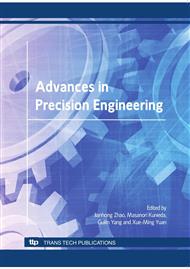p.549
p.554
p.559
p.564
p.569
p.574
p.579
p.584
p.590
Quality Control Method Based on Gear Tooth Contact Evaluation Using Near-Infrared Ray Imagery
Abstract:
Conventionally, tooth contact evaluation has been performed visually by machine operators in gear manufacturing fields when finishing a gear or during assembly. With automation, the contact area’s boundary is unclear due to scattered light when visible light is used to obtain an image for tooth contact evaluation. We therefore focused on using near-infrared to prevent scattered light. First, we confirmed that the tooth contact image obtained by image binarization is hardly affected by the image threshold. Second, we propose a new method to extract the boundary part of the tooth contact by differential calculation of the fine near-infrared image. These methods allow automatic division of near-infrared images into the contact area, the boundary, and the non-contact area. Finally, the obtained result is compared with the tooth contact calculated from the measured tooth surface. We demonstrated that the near-infrared image method is effective for automatic tooth contact evaluation.
Info:
Periodical:
Pages:
569-573
Citation:
Online since:
September 2010
Keywords:
Price:
Сopyright:
© 2010 Trans Tech Publications Ltd. All Rights Reserved
Share:
Citation:


